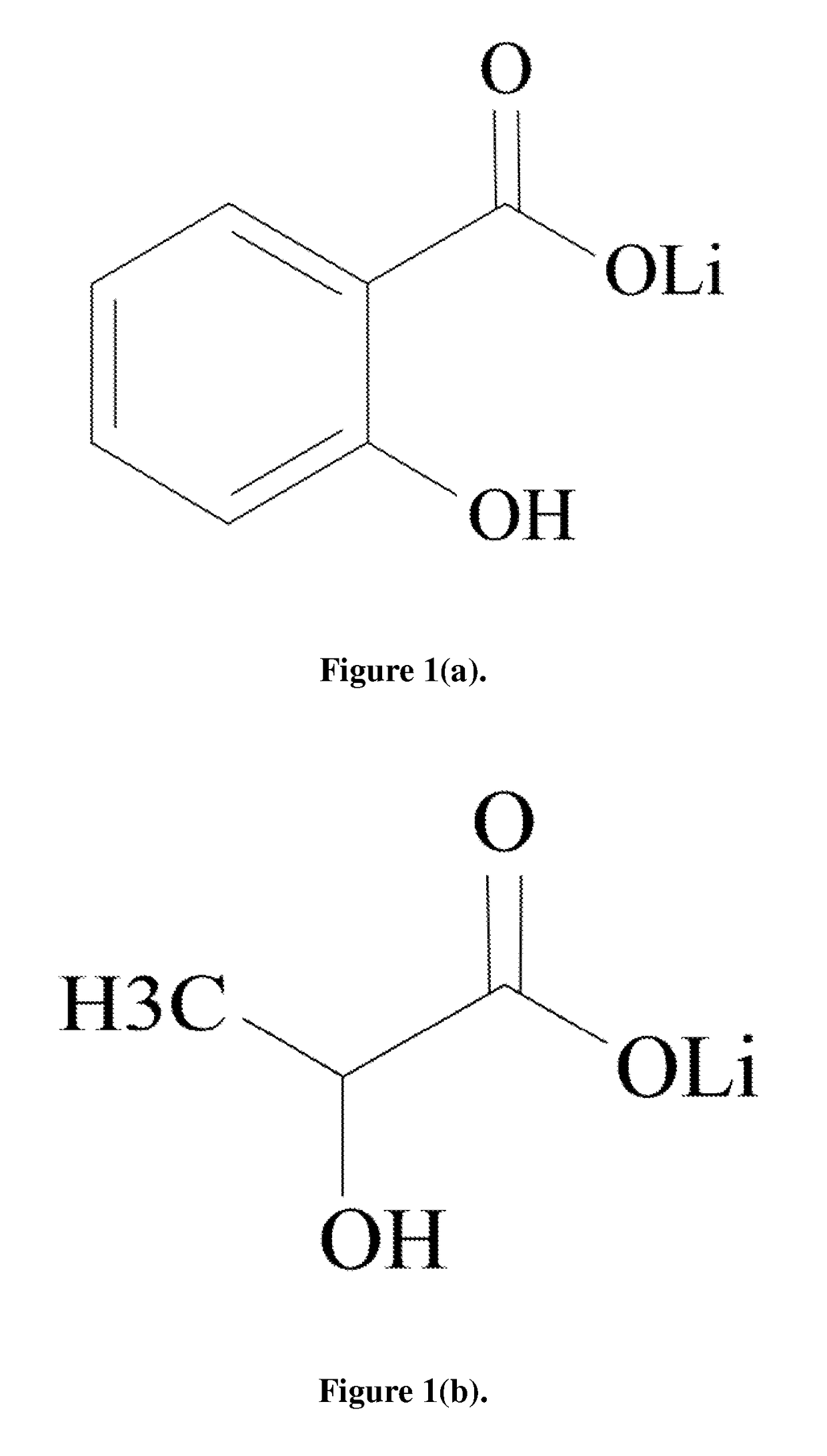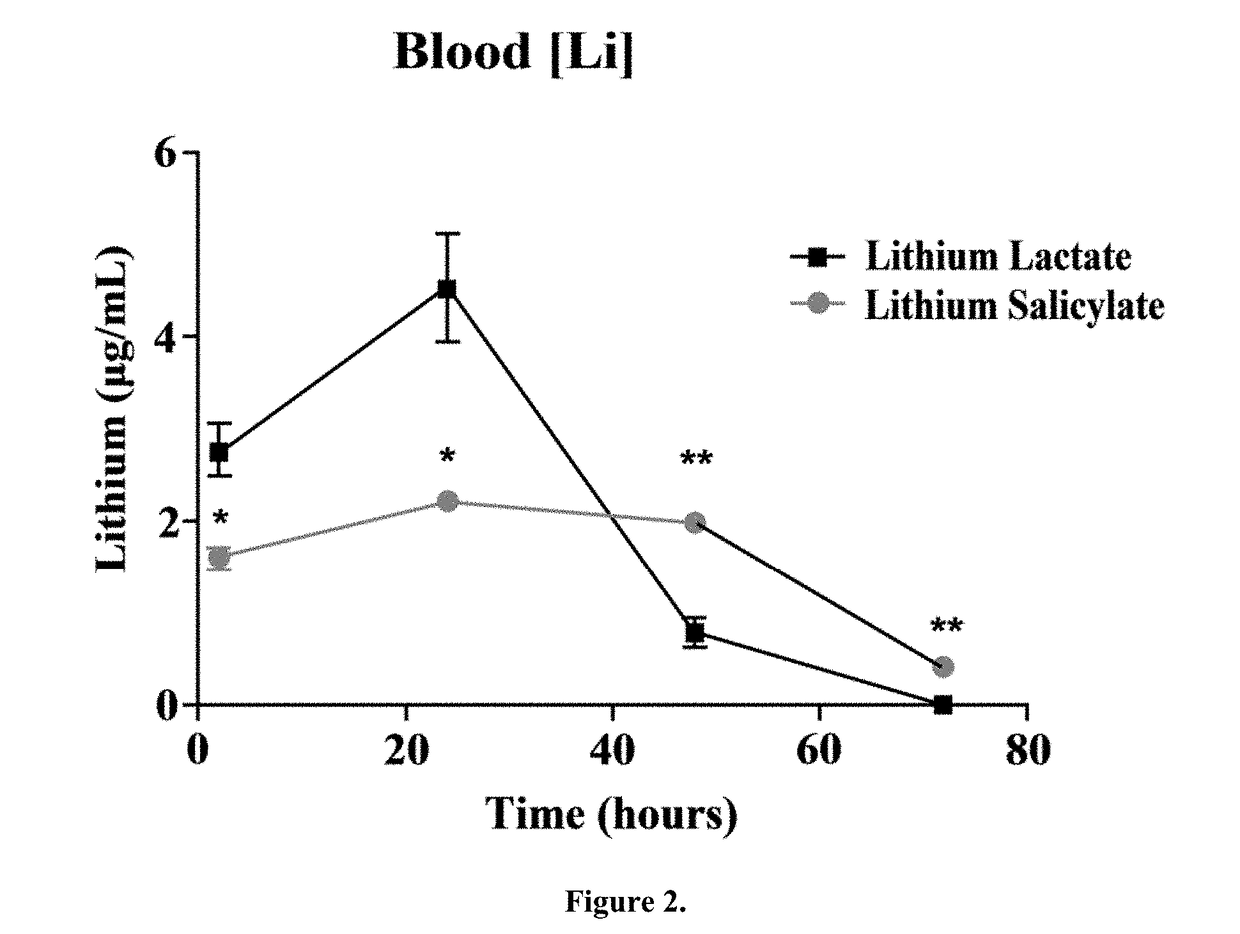Compositions of lithium salts and methods of use
a lithium salt and lithium salt technology, applied in the field of lithium salts, can solve the problems of toxic lithium bromide and lithium chloride, inability to test, and assumed toxicity of lithium fluoride and lithium iodide,
- Summary
- Abstract
- Description
- Claims
- Application Information
AI Technical Summary
Benefits of technology
Problems solved by technology
Method used
Image
Examples
example 1
[0065]Male Sprague Dawley rats weighing 200-250 grams were housed in a vivarium with a 12 hour light-dark cycle. The rats were allowed to acclimate for a period of one week before any experiments were carried out, and were allowed free access to food and water throughout the experiment. The rats were dosed via oral gavage with 4 mEq / kg lithium salicylate (≧98% purity; Aldrich Corporation, St. Louis, Mo., USA) or lithium lactate (≧95% purity; Aldrich Corporation, St. Louis, Mo., USA) dissolved in deionized water. Chemical structures are shown in FIGS. 1(a) and (b).
[0066]Animals in each treatment group were euthanized at 2, 24, 48, and 72 hours (n=3 / time point) and blood was collected by cardiac puncture and carefully perfused with a pressure-controlled pump to maintain microvasculature integrity before removing brain tissue. Blood was centrifuged at 1600×g at room temperature for 10 minutes and plasma was separated. A 500 μl aliquot was diluted 10 fold in a 5% TCA and 10% IPA solutio...
example 2
[0074]Cocrystals are solids that are crystalline single phase materials composed of two or more different molecular and / or ionic compounds (i.e. cocrystal precursors) generally in a stoichiometric ratio. When one or both of the cocrystal precursors are ionic (i.e., salts), the resulting cocrystal is an ionic cocrystal; when both of the cocrystal precursors are molecular (i.e., molecules including zwitterionic molecules), the resulting cocrystal is a molecular cocrystal. Cocrystals of lithium salts are attractive pharmaceuticals, as the compounds can offer improved efficacy due to rational cocrystal selection that permits the precursors to act synergistically (See, Braga et al., Combining piracetam and lithium salts: ionic co-crystals and co-drugs? Chem Commun (Camb). 2012 Aug. 25; 48(66):8219-21; Wouters, et al., Novel Pharmaceutical Compositions through Co-crystallization of Racetams and Li+ Salts. Cryst Eng Comm. 2013 Aug. 2, 15:8898-8902).
[0075]The problems associated with lithiu...
example 3
[0080]Cocrystals, as discussed in Example 2, were formed from lithium salicylate and beta alanine (LiSBAl) were formed in a 1:1 molar ratio. Lithium hydroxide (>98%, anhydrous, used as received from Sigma Aldrich, 23.9 mg, 1.0 mmol), Salicylic acid (>99% used as received from Sigma Acros Organics, 138.1 mg, 1.0 mmol) and beta alanine (99+% pure, used as received from Aldrich, 178.1 mg, 2.0 mmol)) were dissolved in 5.0 mL of deionized water. The solution was evaporated on a hot plate until crystals emerged from solution. Colorless plates (85.0 mg) were collected from the hot solution.
[0081]Crystals of LiSBAl were characterized by single crystal x-ray crystallography, as seen in Table 3, and powder x-ray diffraction (Bricker D8 advance, Cu radiation). Single crystal x-ray crystallography exhibited major peaks lie at about the following positions: 7.4, 12.0, 15.0, 19.8, 22.3, 24.5 and 25.8, as seen in FIG. 8.
[0082]As in the previous example, a comparison of experimental and calculated ...
PUM
| Property | Measurement | Unit |
|---|---|---|
| Time | aaaaa | aaaaa |
| Time | aaaaa | aaaaa |
| Time | aaaaa | aaaaa |
Abstract
Description
Claims
Application Information
 Login to View More
Login to View More - R&D
- Intellectual Property
- Life Sciences
- Materials
- Tech Scout
- Unparalleled Data Quality
- Higher Quality Content
- 60% Fewer Hallucinations
Browse by: Latest US Patents, China's latest patents, Technical Efficacy Thesaurus, Application Domain, Technology Topic, Popular Technical Reports.
© 2025 PatSnap. All rights reserved.Legal|Privacy policy|Modern Slavery Act Transparency Statement|Sitemap|About US| Contact US: help@patsnap.com



